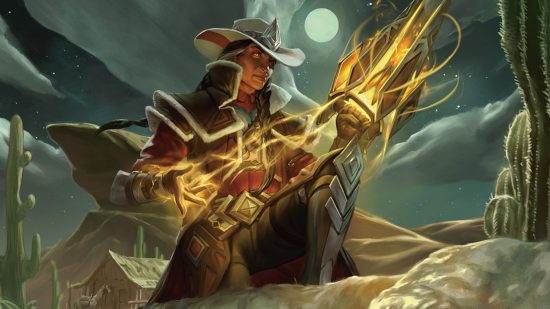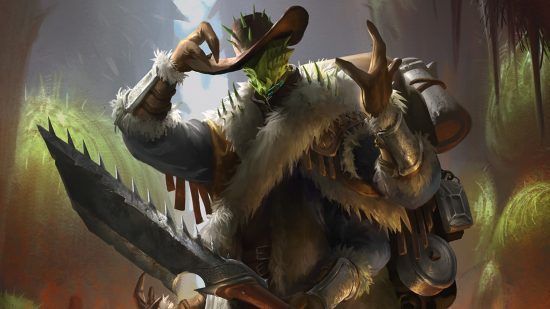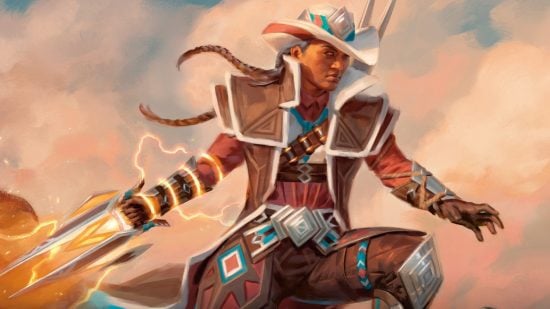Wizards of the Coast has stated that the setting of upcoming Magic: The Gathering set Outlaws of Thunder Junction was deserted before all the criminals, planeswalkers, and cactus men showed up. But this is Magic: The Gathering’s Western-inspired frontier set, and in real life America was decidedly not uninhabited before European settlers rocked up with their Stetsons and their smallpox.
It would be strange, and decidedly uncomfortable to leave the Native American presence out of such a blatant ‘Wild West’ plane, and Wizards has avoided doing this by including the character Annie, and the Atiin, a Native-inspired tribe of nomads, who – like everyone else on MTG Thunder Junction – come from another world. Unusual interpretation of the word ‘native’, that.
Okay, that’s needlessly sarcastic, we’re sorry. And Wizards of the Coast has clearly given quite a bit of thought to this issue. We asked their worldbuilding team, which includes a cultural consultant brought in specifically for this MTG set, what they were going for here. They say, “Our focus was on including aspirational and exciting Native-inspired characters.”
They’ve certainly succeeded in that goal, as Annie Flash (real name Haseya) is pretty badass.
But as far as we can tell, there seems to be a fundamental tension in Thunder Junction, one that may be impossible for the TCG to completely resolve.
Duelling aims?
Wizards wants this set to be one that celebrates mustache-twirling villainy, where crime in the Wild West is seen as a fun activity for players to engage in (which is why it has mechanics named crime, plot, and spree). But it runs into some of the same difficulties as the gangster-themed set Streets of New Capenna: how do you make real-world criminals fun without marginalizing their victims?
In this case the problems are even more amplified. How do you include Native Americans in a Western setting without addressing the horrors inflicted upon them in the real-world history of the American West?
Clearly, Wizards is well aware of the possible controversy. Making Thunder Junction an uninhabited plane not only smacks of sanitizing history, it could be taken as playing into the real-world frontier-time myth of an empty wilderness.
The company’s worldbuilding team referred explicitly to this in its statement to us, saying that, “any western or frontier-inspired entertainment, whether it aims to or not, must wrestle with the real history of Native Americans in the American West and the myth of a western frontier empty of native peoples.”
An upcoming twist?
Wizards tells us that its goal with Outlaws of Thunder Junction was both to have positive Native-inspired representation, and to “seed the prospect that a fully realized Atiin home plane does exist”, adding that “It’s a plane that we hope to explore more deeply in the future.”
That sounds like a fairly positive, though obviously imperfect solution, but it might be the best Wizards is able to do given the conflicting themes of the set.
However, the fact that the worldbuilding team specifically said it was addressing and wrestling with the myth of an empty frontier gives us pause for thought. Could it be that Thunder Junction originally was a home to the Atiin?
This Reddit thread presents an intriguing theory. It’s already believed that, while currently uninhabited, the Fomori of the Coin Empire have left their vaults on Thunder Junction. That’s the same Coin Empire who tried to colonize the Mesoamerican-inspired plane of Ixalan.
So what if the Coin Empire previously drove the Atiin off their home plane, forcing them to become nomads, and this happened so long ago that no one now remembers?
As the theory’s author, TheNuclearOtaku, puts it “this idea of a foreign invader driving natives off of their homeland and forcing them to live somewhere else for so long that they lose their connection to their original homeland, would be a massive parallel to native peoples being forced off of their native lands and onto reservations”.
It would also allow the set’s plot to focus on themes of Native-inspired characters rediscovering their heritage, providing a point of connection for a modern day audience.
We’re sold. Having been previously utterly convinced that Ikoria was related to the Eldrazi, I’m wary of reaching for my tin-foil hat too early.
Let’s just say, if this theory is wrong, you should go back and time and do this, Wizards. And if it is bang on, then well played!


